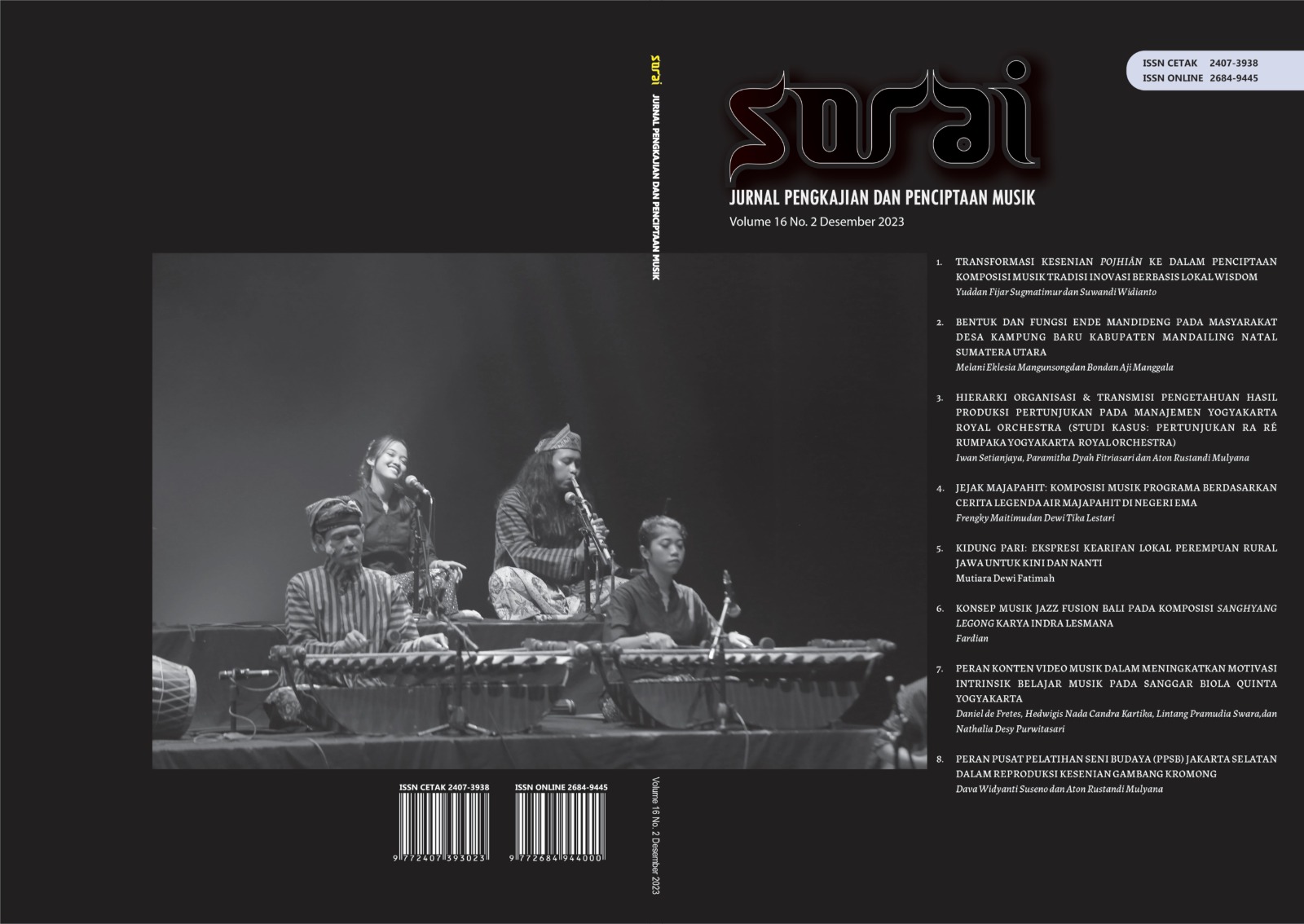BENTUK DAN FUNGSI ENDE MANDIDENG PADA MASYARAKAT DESA KAMPUNG BARU KABUPATEN MANDAILING NATAL SUMATERA UTARA
Main Article Content
Abstract
The article “The Form and Function of Ende Mandideng in the Community of Kampung Baru Village,Mandailing Natal Regency, North Sumatra”, is a presentation of a study to answer two problems, (1) what is the form of Mandideng singing in the community of Kampung Baru Village, North Panyabungan District, Mandailing Natal Regency, Province North Sumatra, and (2) how the Mandideng song functions in the culture of the people of Kampung Baru Village. The research in this article applies qualitative research methods using field research methods under the umbrella of Budilinggono and Alan’s theory. P. Merriam about the form of serving as well as function and uses. According to Budilinggono, the presentation form analyzes melodic phrases in songs and song structures related to rhythmic, melodic and time signature motifs. According to Merriam, an analysis of use and function includes a discussion of how music is used in human activities and the reasons why music is used. The results of the research in this article state that Ende Mandideng, in content analysis, reveals the concept of moral instillation in children. In terms of its function, Ende Mandideng has five functions, namely: (1) emotional expression function, functioned to express the parents’ love for their children when putting the child to sleep, (2) entertainment function, functioned as a reliever of parents’ boredom from their daily activities, ( 3) communication function, functions as a means of conveying messages through songs sung by parents to their children, (4) function of strengthening adjustment to social norms, this function can explain that Mandideng songs have the power to instill the child’s mindset. children from childhood in accordance with applicable social norms, especially regarding social norms related to the relationship between children and parents, (5) the function of preserving and stabilizing culture, functioning as the preservation of folk songs which are currently almost being displaced by developments over time.
Downloads
Article Details

This work is licensed under a Creative Commons Attribution-ShareAlike 4.0 International License.
Copyright
Authors who publish to Sorai: Jurnal Pengkajian dan Penciptaan Musik agrees to the following terms:
- Authors retain copyright and grant the journal right of first publication with the work simultaneously licensed under a Creative Commons Attribution License (CC BY-SA 4.0) that allows others to share the work with an acknowledgment of the work's authorship and initial publication in this journal.
- Authors can enter into separate, additional contractual arrangements for the non-exclusive distribution of the journal's published version of the work (e.g., post it to an institutional repository or edit it in a book), with an acknowledgment of its initial publication in this journal.
- Authors are permitted and encouraged to post their work online (e.g., in institutional repositories or on their website) before and during the submission process, as it can lead to productive exchanges, as well as earlier and greater citation of published work.
References
Budilinggono, I. Bentuk dan Analisis Musik. Jakarta: Departemen Pendidikan dan Kebudayaan,1993.
Dalimunthe, Deni E. M. 2011. “Tor-Tor pada Upacara Adat Perkawinan Masyarakat Tapanuli Selatan,” Gesture Jurnal Seni Tari Thn.2011:1-11.
Koentjaraningrat. Pengantar Antropologi Pokok-Pokok Etnografi II. Jakarta: Rineka Cipta,1997.
Merriam, Allan P. The Anthropology of Music. United States of America: North Western University Press,1964.
Mukti Patria, Endang Widyastuti. 2018. “Peran Ayah dalam Masyarakat Jawa: Tinjauan Psikologi Indigenous,” Jurnal
Psikohumanika Vol. X, No. 1 (Juni 2018): 62-78.
Muminah, A., & Salim, H. 2022. “Fenomena Komunikasi Haptika antara Ibu dan Bayi Saat Menggendong,” Jurnal Desain Idea Vol. 21, No.2 (Oktober 2022): 40-44.
Nugrahani, F. 2012. “Reaktualisasi Tembang Dolanan Jawa dalam Rangka Pembentukan Karakter Bangsa (Kajian Semiotik)” Kajian Linguistik dan Sastra, Vol. 24, No. 1 (Juni 2012): 58-68.
Ristanti, S. S. D. M., Rachmawati, R., & Hanafiah, U. I. M. 2015. “Perancangan Mom and Baby Spa Center di Bekasi Sebagai Sarana Untuk Mengoptimalkan Momen Kebersamaan Ibu dan Anak” e-Proceeding of Art & Design: Vol.2, No.2 (Agustus 2015): 886-892.
Sihombing, Octa Maria. 2015. “Bentuk Lagu dan Makna Ende Bue-Bue pada Masyarakat Mandailing di Kelurahan Losung Padangsidimpuan”. Skripsi. Fakultas Bahasa dan Seni, Universitas Negeri Medan.
Silaban, Demak Magdalena. 2014. “Tradisi Lisan Nyanyian Rakyat Anak-Anak pada Masyarakat Batak Toba”. Tesis. Fakultas Ilmu Budaya, Universitas Sumatera Utara, Medan.
Simanjuntak, RM Sihombing DI 2020. “Etnomatematika dalam Transposisi Akord Ende Mandideng”. Skripsi. Universitas HKBP Nomensen.
Sinaga Asnita, Natalia Laowo. 2020. “Pengaruh Pijat Bayi terhadap Kualitas Tidur Bayi Usia 0-6 Bulan di BPM Pera Kecamatan Medan Tuntungan Tahun 2019,” Excellent Midwifery Journal Vol. 3 No. 1 (April 2020): 27-31.
Tamba, Gusti 2014. “Kajian Fungsi, Makna, dan Eksistensi Nyanyian Ende Tumba pada Masyarakat Pangururan Samosir”. Skripsi. Fakultas Bahasa dan Seni, Universitas Negeri Medan.
